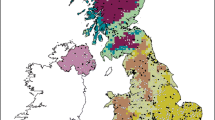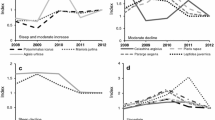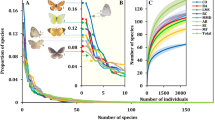Abstract
Since the first Butterfly Monitoring Scheme in the UK started in the mid-1970s, butterfly monitoring in Europe has developed in more than ten European countries. These schemes are aimed to assess regional and national trends in butterfly abundance per species. We discuss strengths and weaknesses of methods used in these schemes and give examples of applications of the data. A new development is to establish supra-national trends per species and multispecies indicators. Such indicators enable to report against the target to halt biodiversity loss by 2010. Our preliminary European Grassland Butterfly Indicator shows a decline of 50% between 1990 and 2005. We expect to develop a Grassland Butterfly Indicator with an improved coverage across European countries. We see also good perspectives to develop a supra-national indicator for climate change as well as an indicator for woodland butterflies.






Similar content being viewed by others
References
Balmford A, Bennun L, Ten Brink B, Cooper D, Côté IM, Crane P, Dobson AP, Dudley N, Dutton I, Green RE, Gregory RD, Harrison J, Kennedy ET, Kremen C, Leader Williams N, Lovejoy TE, Mace P, May RM, Mayaux P, Morling P, Phillips J, Redford K, Ricketts TH, Rodriguez JP, Sanjayan MA, Schei PJ, Van Jaarsveld AS, Walther BA (2005) The convention on biological diversity’s 2010 target. Science 307:212–213
Brereton T, Warren MS (2005) The use of transect monitoring 2: assessing the impacts of conservation policy and management on butterfly populations. In: Warren M, Pullin A (organizers) Lepidoptera as indicators of biodiversity conservation. 5th international symposium, Southampton University, 8th–10th April 2005
Brown JA, Boyce MS (1998) Line transect sampling of Karner blue butterflies (Lycaeides melissa samuelis). Environ Ecol Stat 5:81–91
Buckland ST, Magurran AE, Green RE, Fewster RM (2005) Monitoring change in biodiversity through composite indices. Philos Trans R Soc Lond B Biol Sci 360:243–254
De Heer M, Kapos V, Ten Brink BJE (2005) Biodiversity trends in Europe: development and testing of a species trend indicator for evaluating progress towards the 2010 target. Philos Trans R Soc Lond B Biol Sci 360:297–308
Dennis RLH, Sparks TH, Hardy BP (1999) Bias in butterfly distribution maps: the effect of sampling effort. J Insect Conserv 3:33–42
Dennis RLH, Shreeve TG, Isaac NJB, Roy DB, Hardy PB, Fox R, Asher J (2006) The effects of visual apparency on bias in butterfly recording and monitoring. Biol Conserv 128:486–492
European Environment Agency (2007) Halting the loss of biodiversity by 2010: proposal for a first set of indicators to monitor progress in Europe. Office for Official Publications of the European Communities. http://reports.eea.europa.eu. Cited 6 Dec 2007
Gaston KJ (1991) The magnitude of global insect species richness. Conserv Biol 5:283–296
Gregory RD, Van Strien AJ, Vorisek P, Gmelig Meyling AW, Noble DG, Foppen RPB, Gibbons DW (2005) Developing indicators for European birds. Philos Trans R Soc Lond B Biol Sci 360:269–288
Gregory RD, Vorisek P, Van Strien AJ, Gmelig Meyling AW, Jiguet F, Fornasari L, Reif J, Chylarecki P, Burfield IJ (2007) Population trends of widespread woodland birds in Europe. Ibis 49(s2):78–97
Gregory RD, Vorisek P, Noble DG, Van Strien AJ, Pazderová A, Eaton ME, Gmelig Meyling AW, Joys A, Foppen RPB, Burfield IJ (2008) The generation and use of bird population indicators in Europe. Bird Conserv Int 18:223–244
Groombridge B (1992) Global biodiversity: status of the Earth’s living resources. Chapman & Hall, London
Hambler C, Speight MR (1996) Extinction rates in British non-marine invertebrates since 1900. Conserv Biol 10:892–896
Hambler C, Speight MR (2004) Extinction rates and butterflies. Science 305:1563
Harker RJ, Shreeve TG (2008) How accurate are single site transect data for monitoring butterfly trends? Spatial and temporal issues identified in monitoring Lasiommata megera. J Insect Conserv 12:125–133
Heliölä J, Kuussaari M (2005) How many counts are needed? Effect of sampling effort on observed species numbers of butterflies and moths in transect counts. In: Kühn E, Feldmann R, Thomas JA, Settele J (eds) Studies on the ecology and conservation of butterflies in Europe. Vol. 1: general concepts and case studies. Pensoft, Sofia, pp 83–84
Henry P-Y, Lengyel S, Nowicki P, Julliard R, Clobert J, Čelik T, Gruber B, Schmeller DS, Babij V, Henle K (2008) Integrating ongoing biodiversity monitoring: potential benefits and methods. Biodivers Conserv (this volume). doi:10.1007/s10531-008-9417-1
Henry P-Y, Manil L, Cadi A, Julliard R (2005) Two national initiatives for butterfly monitoring in France. In: Kühn E, Thomas JA, Feldmann R, Settele J (eds) Studies on the ecology and conservation of butterflies in Europe. Vol. 1: general concepts and case studies. Pensoft, Sofia, 85 pp
Kéry M, Plattner M (2007) Species richness estimation and determinants of species detectability in butterfly monitoring programmes. Ecol Entomol 32:53–61
Kühn E, Feldmann R, Thomas JA, Settele J (2005) Studies on the ecology and conservation of butterflies in Europe. Vol. 1: general concepts and case studies. Pensoft, Sofia, 123 pp
Kühn E, Feldmann R, Harpke A, Hirneisen N, Musche M, Leopold P, Settele J (2008) Getting the public involved into butterfly conservation—lessons learned from a new monitoring scheme in Germany. Israel J Ecol Evol 54:89–103
Maes D, Van Swaay CAM (1997) A new methodology for compiling national red Lists applied to butterflies (Lepidoptera, Rhopalocera) in Flanders (N-Belgium) and The Netherlands. J Insect Conserv 1:113–124
May RM (1988) How many species are there on earth? Science 241:1441–1449
McCullagh P, Nelder JA (1989) Generalized linear models, 2nd edn. Chapman & Hall, London
Mulder CT, Aldenberg D, De Zwart D, Van Wijnen HJ, Breure AM (2005) Evaluating the impact of pollution on plant–Lepidoptera relationships. Environmetrics 16:357–373. doi:10.1002/env.706
Nowicki P, Richter A, Glinka U, Holzschuh A, Toelke U, Henle K, Woyciechowski M, Settele J (2005) Less input same output–simplified approach for population size assessment in Lepidoptera. Popul Ecol 47:203–212
Nowicki P, Settele J, Henry P-Y, Woyciechowski M (2008) Butterfly monitoring methods: the ideal and the real world. Israel J Ecol Evol 54:69–88
Oostermeijer G, Van Swaay CAM (1998) The relationship between butterflies and environmental indicator values: a tool for conservation in a changing landscape. Biol Conserv 86:271–280
Pannekoek J, Van Strien AJ (2005) TRIM 3 manual. Trends and indices for monitoring data. CBS, Statistics Netherlands, Voorburg, Netherlands. (freely available via www.ebcc.info)
Pellet J (2008) Seasonal variation in detectability of butterflies surveyed with Pollard walks. J Insect Conserv 12:155–162
Pollard E (1977) A method for assessing change in the abundance of butterflies. Biol Conserv 12:115–132
Pollard E, Yates TJ (1993) Monitoring butterflies for ecology and conservation: the British Butterfly Monitoring Scheme. Conservation biology series No. 1. Chapman & Hall, London
Pollard E, Hall ML, Bibby TJ (1986) Monitoring the abundance of butterflies 1976–1985. Research and Survey in Nature Conservation Series No. 2. Nature Conservancy Council, Peterborough
Pollock KH, Nichols JD, Simons TR, Farnsworth GL, Bailey LL, Sauer JR (2002) Large scale wildlife monitoring studies: statistical methods for design and analysis. Environmetrics 13:105–119
Rothery P, Roy DB (2001) Application of generalized additive models to butterfly transect count data. J Appl Stat 28:897–909
Roy DB, Sparks TH (2000) Phenology of British butterflies and climate change. Glob Change Biol 6:407–416
Roy DB, Rothery P, Brereton T (2005) The design of a systematic survey scheme to monitor butterflies in the United Kingdom. In: Kühn E, Feldmann R, Thomas JA, Settele J (eds) Studies on the ecology and conservation of butterflies in Europe. Vol. 1: general concepts and case studies. Pensoft, Sofia, pp 102–105
Roy DB, Rothery P, Brereton T (2007) Reduced-effort schemes for monitoring butterfly populations. J Appl Ecol 44:993–1000
Schmeller D, Gruber B, Bauch B, Henle K (2006) EuMon–Arten- und Lebensraum-Monitoring in Europa. Naturschutz und Landschaftsplanung 39:384–385
Schweiger O, Settele J, Kudrna O, Klotz S, Kühn I (in press) Climate change can cause spatial mismatch of trophically interacting species. Ecology
Settele J (1998) Metapopulationsanalyse auf Rasterdatenbasis - Modellgestützte Analyse von Metapopulationsparametern und naturschutzfachliche Umsetzung im Landschaftsmaßstab, erläutert am Beispiel von Tagfaltern. Teubner, Leipzig/Stuttgart. 130 pp
Settele J, Andrick U, Pistorius EM (1992) Zur Bedeutung von Trittsteinbiotopen und Biotopverbund in der Geschichte - das Beispiel des Hochmoorperlmutterfalters (Boloria aquilonaris Stichel 1908) und anderer Moorvegetation bewohnender Schmetterlinge in der Pfalz (SW-Deutschland). Nota lepidopterologica, Supplementum No. 4 (Proc. 7.SEL-Kongreß, Lunz/Österreich 1990), pp 18–31
Settele J, Hammen V, Hulme P, Karlson U, Klotz S, Kotarac M, Kunin W, Marion G, O’Connor M, Petanidou T, Peterson K, Potts S, Pritchard H, Pysek P, Rounsevell M, Spangenberg J, Steffan-Dewenter I, Sykes M, Vighi M, Zobel M, Kühn I (2005) ALARM–Assessing large-scale environmental risks for biodiversity with tested methods. GAIA-Ecol Perspect Sci Soc 14(1):69–72
Settele J, Dover J, Dolek M, Konvicka M (2009) Butterflies of European ecosystems: impact of land use and options for conservation management. In: Settele J, Shreeve T, Konvicka M, Van Dyck H (eds) Ecology of butterflies in Europe. Cambridge University Press, Cambridge
Shreeve TG (1984) Habitat selection, male location, and microclimatic constraints on activity of the speckled wood butterfly Pararge aegeria (L.) (Lepidoptera: Satyridae). Oikos 42:371–377
Soldaat L, Visser H, Van Roomen M, Van Strien AJ (2007) Smoothing and trend detection in waterbird monitoring data using structural time-series analysis and the Kalman filter. J Ornithol 148(suppl 2):351–357
Stefanescu C, Penuelas J, Filella I (2003) Effects of climate change on the phenology of butterflies in the northwest Mediterranean Basin. Glob Change Biol 9:1494–1506
Sutherland WJ (2006) Ecological census techniques, 2nd edn. Cambridge University Press, Cambridge
Telfer MG, Preston CD, Rothery P (2002) A general method for measuring relative change in range size from biological atlas data. Biol Conserv 107:99–109
Thomas JA (1983) A quick method for estimating butterfly numbers during surveys. Biol Conserv 27:195–211
Thomas JA (2005) Monitoring change in the abundance and distribution of insects using butterflies and other indicator groups. Philos Trans R Soc Lond B Biol Sci 360:339–357
Thomas CD, Abery JCG (1995) Estimating rates of butterfly decline form distribution maps: the effects of scale. Biol Conserv 73:59–65
Thomas JA, Clarke RT (2004) Extinction rates and butterflies–response. Science 305:1563–1564
Thomas JA, Telfer MG, Roy DB, Preston CD, Greenwood JJD, Asher J, Fox R, Clarke RT, Lawton JH (2004) Comparative losses of British butterflies, birds, and plants and the global extinction crisis. Science 303:1879–1881
Van Strien AJ, Plantenga WF, Soldaat LL, Van Swaay CAM, WallisDeVries MF (2008) Bias in phenology assessments based on first appearance data of butterflies. Oecologia. doi: 10.1007/s00442-008-0959-4
Van Swaay CAM (1990) An assessment of the changes in butterfly abundance in The Netherlands during the 20th Century. Biol Conserv 52(4):287–302
Van Swaay CAM (2007) Workshop Development of the methodology for a European butterfly indicator. Report VS2007.006, De Vlinderstichting, Wageningen
Van Swaay CAM, Van Strien AJ (2005) Using butterfly monitoring data to develop a European grassland butterfly indicator. In: Kühn E, Thomas JA, Feldmann R, Settele J (eds) Studies on the ecology and conservation of Butterflies in Europe. Vol. 1: general concepts and case studies. Pensoft, Sofia, pp 106–108
Van Swaay CAM, Warren MS (1999) Red data book of European butterflies (Rhopalocera). Nature and Environment, No. 99. Council of Europe, Strasbourg
Van Swaay CAM, Warren MS (eds) (2003) Prime butterfly areas in Europe: priority sites for conservation. National Reference Centre for Agriculture, Nature and Fisheries, Ministry of Agriculture, Nature Management and Fisheries, The Netherlands
Van Swaay CAM, Plate CL, Van Strien A (2002) Monitoring butterflies in the Netherlands: how to get unbiased indices. In: Proc Exper Appl Entomol NEV Amsterdam, vol 13. pp 21–27
Van Swaay CAM, Warren MS, Lois G (2006) Biotope use and trends of European butterflies. J Insect Conserv 10:189–209
WallisDeVries MF, Van Swaay CAM (2006) Global warming and excess nitrogen may induce butterfly decline by microclimatic cooling. Global Change Biology 12(9):1620–1626
Zonneveld C (1991) Estimating death rates from transect counts. Ecol Entomol 16:115–121
Acknowledgements
This paper was written with financial support from EuMon (http://eumon.ckff.si; contr. number 6463; Schmeller et al 2006); and EU FP6 Integrated Project “ALARM” (www.alarmproject.net; GOCE-CT-2003-506675; Settele et al. 2005), two research projects supported by the European Commission under the 6th Framework Programme. The following people gave help and support to develop the European grassland butterfly indicator: David Roy, Tom Brereton, Sergey Popov, Patrick Leopold, Dirk Maes, Constanti Stefanescu, Petra Ramseier, Mikko Kuussaari, Dominique Langlois and Tim Pavlicek. Adriaan Gmelig Meyling helped in producing the supranational indices and the final European Grassland Butterfly Indicator. We also want to thank Pierre-Yves Henry and two other anonymous reviewers for their inspiring comments. Last but not least, Butterfly Monitoring Schemes would never have been possible without the cooperation of hundreds of voluntary recorders all over Europe.
Author information
Authors and Affiliations
Corresponding author
Rights and permissions
About this article
Cite this article
van Swaay, C.A.M., Nowicki, P., Settele, J. et al. Butterfly monitoring in Europe: methods, applications and perspectives. Biodivers Conserv 17, 3455–3469 (2008). https://doi.org/10.1007/s10531-008-9491-4
Received:
Accepted:
Published:
Issue Date:
DOI: https://doi.org/10.1007/s10531-008-9491-4




